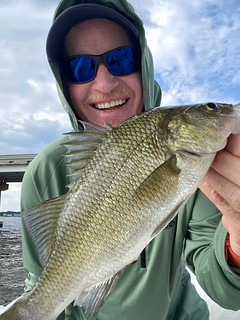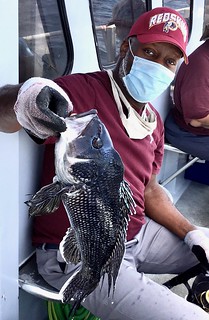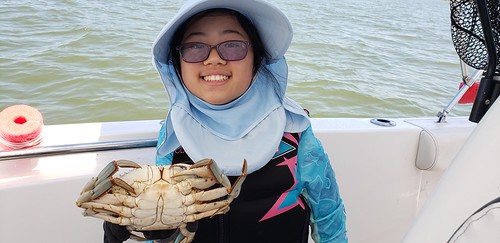Maryland Fishing Report – July 1
Elizabeth Lee went crabbing with her parents and is contributing to the crab feast with this catch. Photo courtesy of Elizabeth Lee
The Fourth of July holiday weekend means outdoor adventure seekers will be out in droves. Be safe and use common sense — if you’re boating, use a personal flotation device and never boat under the influence of drugs or alcohol. For all anglers, remember also to keep a social distance and avoid crowded areas.
The Maryland Department of Natural Resources offers a final license-free fishing day for 2020 on July 4 — a free option to explore Maryland’s diverse and unique fishing experiences without needing a fishing license, trout stamp, or registration.
Biologists have instituted several volunteer angler surveys to help them understand and better manage some of the important fish species to anglers as well as blue crabs and horseshoe crabs.
As we enter Maryland’s warmest months, the department’s online striped bass fishing advisory forecast provides a seven-day outlook to help anglers reduce striped bass mortality during the summer fishing season.

Expect warm, sunny skies and low winds all week. Chesapeake Bay surface water temperatures have jumped to the low 80s. These warming waters and corresponding low oxygen areas are appearing from Swan Point down to the mouth of the Potomac River. In areas north of Bloody Point, to find suitable oxygen for game fish, avoid fishing much deeper than 20 feet.
With river temperatures in the low 80s, striped bass will be found in deeper, oxygenated waters on cooler river mouths or main bay structure. White perch can be found on tidal creek mouths on mud, sand, or clay bottoms near waters less than 20 feet deep. Adult spot can be found all the way up to the upper Chesapeake Bay mainstem and tributaries in areas with salinities greater than 5ppt — currently south of the Bay Bridge — on oyster bars, sand, and mud bottom, feeding on benthic worms and small clams.
Expect reduced water clarity from algal blooms near Eastern Bay and on the western shore near Chesapeake Beach. On the Potomac River, expect poorer-than-normal water clarity from Piney Point down to Point Lookout.
To see the latest water clarity conditions, check our Eyes on the Bay Satellite Maps.
Expect normal flows in most of Maryland’s rivers and streams. There will be above average tidal currents all week as a result of the upcoming full moon July 5.
For more detailed and up-to-date fishing conditions in your area of the bay, be sure to check out Click Before You Cast. Get regular updates on Maryland’s waters sent to your inbox with our Eyes on the Bay newsletter. Sign up online.

Jigging near deeper structure such as the bridge piers at the Bay Bridge has been very good this week and Bob Bruns shows how it is done when jigging with small metal jigs. Photo courtesy of Bob Bruns
There continues to be a fun early morning striped bass fishery at the Conowingo Dam pool. At the crack of dawn, anglers are casting topwater lures as far as they can into the dam pool near the turbines. Zara Spooks, poppers, and floating jerkbaits are the most popular topwater lures being used. As the morning hours wear on switching to soft plastic sassy shads, Storm type swimbaits and paddletails can extend the action a few more hours. Casting fresh cut bait is a great way to target catfish — flathead as well as blues and channel cats.
In the lower parts of the Susquehanna River and the channel edges near the Flats, there is an early morning topwater bite for striped bass, and in the evening to a lesser degree. Topwater lures cast into the shallower edges works well. Casting soft plastics into deeper waters and live-lining small white perch also works well for many anglers.
The deep hole in the Susquehanna River just below the railroad bridge continues to be a favorite spot to fish for blue catfish. They also will be found in many of the tidal rivers in the upper bay, with the Chester River population expanding rapidly. Channel catfish are also found in every tidal river. Fresh cut bait and clam snouts are favorite baits but more than a few anglers like using various chicken parts.
Striped bass fishing has been good in the upper bay whether one is trolling, live-lining, jigging, or casting lures. There has been a considerable fleet of boats anchored up at the Tolchester Lumps live-lining and chumming for striped bass, and dead discards are being observed. With warmer air temperatures and water temperatures, care must be taken when handling fish and anglers using live bait or cut bait are reminded that they must use non-offset circle hooks at all times.
Watching depth finders along channel edges is a good way to locate suspended striped bass wherever they might be holding. Locations where striped bass can be found include Swan Point, Love Point Rocks and Podickory Point. Developing a trolling pattern, or setting up to live-line, chum, or jig can put you on your own batch of fish. Umbrella rigs pulled behind inline weights with white or chartreuse bucktails and swimshads as trailers are popular.
Spot and white perch can be caught off the shore of Sandy Point State Park and the mouth of the Magothy River. Pieces of bloodworm work best on a simple bottom rig. Anywhere suspended striped bass can be found along channel edges, along with the Francis Scott Key Bridge piers, the Bay Bridge piers, Pooles Island, and the Love Point rocks are good places to live-line spot or white perch.
Jigging is good also at the Love Point rocks, the Bay Bridge piers and rock piles, and anywhere striped bass can be found suspended. Skirted soft plastic jigs in white, pearl or chartreuse combinations with a little sparkle are working well. Jigs are either worked close to the bridge piers or in the case of Love Point rocks, working a jig in a swinging, walking-the-dog movement in the currents.
White perch fishing is very good in a variety of locations, especially in deeper waters on hard bottom shoal areas and the tidal rivers and creeks. Pieces of bloodworms work well on bottom rigs. During the early morning or evening hours casting small lures near shoreline structure is always a fun way to fish with light tackle.
There are several options for striped bass fishing including trolling, live-lining, jigging, and casting lures near shoreline structure. Trolling weighted umbrella rigs along the 30-foot edge of the shipping channel is providing a slow pick of fish longer than 19 inches. Several traditional locations have been popular, including Buoy 83 and Bloody, Breezy, Hacketts, and Thomas points. White bucktails and swimshads are the favorite color as trailers.

Photo by Eric Packard
Live-lining spot or white perch at those locations is also productive. Spot and white perch can be found in Whitehall Bay, the mouth of the Choptank River, and in front of Chesapeake Beach. Anglers using live bait or cut bait are reminded that they must use non-offset circle hooks at all times.
When striped bass can be found suspended along channel edges with depth finders, jigging can be an effective way to catch them. Watch for breaking fish, which are usually small striped bass, and try jigging deep underneath them. Slicks on the surface of the water or groups of sitting birds can also lead the way to striped bass holding deep.
The shallow-water striped bass fishery that many light-tackle anglers love is beginning to slip into a typical summer mode. This means the best fishing success occurs at the crack of dawn or late in the evening. Striped bass do not feel comfortable in waters above 80 degrees. The rocks at Poplar Island, upper Eastern Bay, and the lower Severn and Choptank rivers are all traditional locations to enjoy this fun topwater action.
White perch are providing plenty of fun fishing in the tidal rivers and creeks whether in a small boat or fishing from shore access points, docks, and fishing piers. Bottom rigs baited with grass shrimp or pieces of bloodworm are a good bet when fishing off docks or out of a boat over oyster bars. Casting small spinners, spinnerbaits, and soft plastic jigs in the morning and evening hours near shoreline structure is always a fun and relaxing pastime.
Striped bass fishing in the Potomac River from the Route 301 Bridge south to the St. Marys River has been good and should continue. Trolling along the steeper channel edges with tandem rigged bucktails dressed with twister tails is working well. Umbrella rigs with bucktails or swimshads as trailers are also favorites. There is also some spotty striped bass trolling going on along the shipping channel edges and in the Patuxent River.

David Penrose Jr. with a huge cobia. Photo courtesy of David Penrose Jr.
There has been a little bit of live-lining activity along the steep channel edge between St. George Island and Piney Point in the lower Potomac River. A few anglers are trying to chum off of Point Lookout for a mix of striped bass and bluefish with the added hope of luring a cobia into a chum slick. Cownose rays are one of the most uninvited guests to chum slicks in the region lately.
Spot are spread out along both sides of the bay. The lower Patuxent River, the mouth of the Honga River, and Tangier Sound are a few of the most popular areas to fish with pieces of bloodworm. Some of the spot are now getting large enough to consider as table fare. White perch are mixed in at these same locations and every tidal river and creek in the region.
Fishing for speckled trout continues to be extremely good with most of the action occurring from Hoopers Island south to Tangier and Pocomoke sounds. Casting pink, white, or pearl/sparkle combinations with soft plastic swimbaits have been the best producing lures to use, as are Gulp baits. In the early morning and late evening hours, casting Zara Spooks over grass or stump fields is a fun way to catch speckled trout and a few striped bass.
Cobia are steadily moving into the region and a few are being caught by chumming or sight casting with live eels or large soft plastic jigs. The Middle Grounds to the Target Ship and Point Lookout are traditional locations to look for them. Large red drum are being caught and released in the Tangier Sound area by jigging or trolling large spoons.
Bluefish are becoming more common in the region and their numbers will most likely increase this month. Right now they are being caught while chumming or live-lining and by trolling with spoons or hose lures. Spanish mackerel are showing up now and then for those trolling small Drone spoons at a faster clip, or as incidental catches when fishing for striped bass. Flounder are also making an appearance in the Tangier Sound area along channel edges.
Recreational crabbing is fairly good in the middle bay region with most being able to catch close to a full bushel per outing of nice heavy crabs. Fortunes increase in the lower bay where most report there is no trouble catching a full bushel of crabs. Razor clams are being used as bait by an increasing number of crabbers and most consider them worth the cost and trouble. As most anglers know, bait is usually the cheapest part of the expenses when going fishing or crabbing.

Photo by John McMullen
The special trout management waters of the western region are providing fun and relaxing fishing opportunities for fly fishermen and for those using light spinning tackle in catch-and-release areas. Most streams and creeks are experiencing good summer flow conditions.
It will be a crazy week with boating traffic at Deep Creek Lake but if one gets out early and tucks into a secluded cove it should not be too bad. Drifting along deep grass lines with minnows is one of the most productive ways to fish for a mix of smallmouth bass, yellow perch, and walleye. Casting soft plastic under floating docks is a great way to target largemouth bass. Slow trolling with minnows or nightcrawlers deep along the dam face is a good way to catch walleye and trout.
Largemouth bass are steadily moving into a summer mode of behavior as water temperatures elevate. Largemouth bass in most areas now are feeding at night in the shallow waters where grass, lily pads, and spatterdock fields provide cover for baitfish. Fish these areas during late evening or early morning hours with soft frogs, buzzbaits, floating soft plastics, and lipless crankbaits. As that sun rises in the morning sky, largemouth bass will seek cool shade under deeper water under grass mats, fallen treetops, sunken wood, or docks. Flipping grubs, weighted soft plastics, hair jigs, and crankbaits near these areas is a good choice.
Northern snakeheads will be found holding in these shallow grass areas in the tidal rivers and although their activity has slowed down a bit, they will go after noisy topwater lures. They may also be found holding near sunken wood along deeper shorelines.
Blue catfish are being caught on shoal areas next to channels in the Potomac River from the Wilson Bridge to the Route 301 Bridge. They are also found in the Patuxent River near Benedict, the Sharptown area of the Nanticoke, and the Dover Bridge area of the Choptank River. Channel catfish are spread throughout all of the tidal rivers and also provide plenty of fun fishing action.
A lot of anglers young and old are enjoying bluegill sunfish using a variety of locations and methods. Taking young anglers down to the local community pond and casting out a worm under a bobber will provide a lot of fun. Getting out in a kayak, canoe, or small boat away from hungry shoreline tree branches with a light weight fly rod and casting small floating poppers and ants offers a lot of fun. Breaking out that ultra-light spinning outfit and casting small lures is just as much fun.

Photo by Monty Hawkins
Surf anglers got a surprise this week as Spanish mackerel began making runs in the surf zones of Ocean City and Assateague. Casting small heavy spoons and speed reeling is a fun way to catch them. Kingfish are being caught on bottom rigs baited with pieces of bloodworm. Bluefish are being caught on finger mullet and cut bait.
At the inlet, bluefish are moving in and out on the tides and being caught on a variety of lures and by drifting cut bait. A few striped bass are being caught at the inlet but most miss the 28-inch minimum mark.
Fishing for flounder is good in the back bay areas. Those fishing in the channel areas need to exercise special caution due to the high volume of boat traffic expected for the holiday weekend. Gulp baits in white or pink tend to be catching the largest flounder and of course traditional baits of squid and minnows work fine.
Spanish mackerel are reported to be caught near the Bass Grounds, which is about 12 miles outside the inlet. They may also be found on some of the inshore shoals. Trolling bright silver spoons behind inline weights at a good clip is usually the best way to catch them. Sea bass fishing is showing signs of slowing down a bit, which is not uncommon this time of year. Chunky sea bass are being caught on traditional baits as well as metal jigs. Large flounder are being caught near the wreck and reef areas on soft plastic jigs, Gulp baits in pink and white tend to be a favorite.
The boats venturing out to the canyons are finding a mix of yellowfin tuna and bigeye tuna. Many captains are reporting that every day is not necessarily a guarantee of limit catches, but some nice yellowfin tuna and a mix of bigeye are coming into the docks each day. Skirted ballyhoo and plastic lures are traditional trolling spread offerings. A few mako sharks and dolphin are also being caught and white marlin are being spotted.
As a reminder: Any harvested bluefin tuna, billfish, swordfish, or shark (except spiny dogfish) must be reported via the Catch Card Census before it is moved from a boat, or point of landing if fishing from shore, to be in compliance with state and federal regulations. Catch cards and tags are available at tackle shops, marinas, and kiosks around Ocean City, and online. Please use the kiosk at the Colonel Jack Taylor Boathouse located in west Ocean City when businesses are closed. Simply fill out the card found in the kiosk and tear off the receipt on the edge of the card, and leave the card in the kiosk.
Dusky and sandbar sharks look similar, and both sharks are prohibited from harvest. If you cannot identify a shark, let it go in the water. State and federal regulations require shark anglers to use corrodible, non-stainless circle hooks except when fishing with artificial flies and lures, and any shark that is not being kept is to be released in the water. Anglers must have a device capable of quickly cutting either the leader or the hook. Identification and compliance information is available from the National Oceanic and Atmospheric Administration.
“There is nothing that attracts human nature more powerfully than the sport of tempting the unknown with a fishing line.” — Henry Van Dyke, 1899
Maryland Fishing Report is written and compiled by Keith Lockwood, Maryland Department of Natural Resources fisheries biologist.
Click Before You Cast is written by Tidewater Ecosystem Assessment Director Tom Parham.
This report is now available on your Amazon Echo device — just ask Alexa to “open Maryland Fishing Report.”
Credit: Source link






























